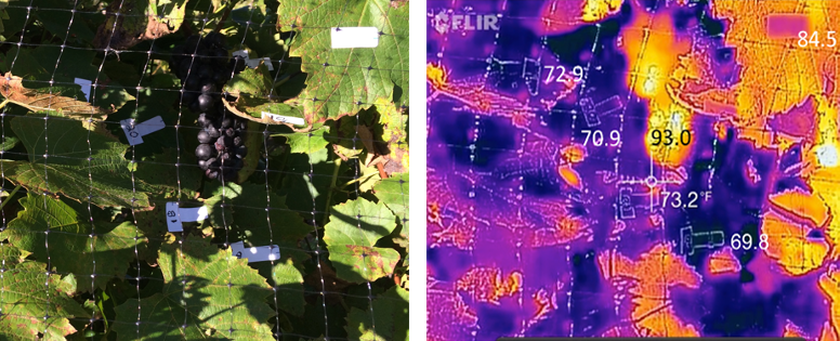|
I have always wondered about how much the temperature varies throughout the vine’s canopy, from shady areas to sunny areas. I have also wondered about how grape clusters, with their dark skins and thermal mass, accumulate heat during the day and dissipate heat at night, relative to the leaves. Thermal imaging is one way to paint a picture of temperature variations in the canopy. Thermal imagers have become consumer products. For less than $200, you can buy a FLIR One thermal imager that snaps into an iPhone and runs from an iPhone app.
The two images above give you an idea of what you can see through an infrared camera (right) compared to a visual spectrum camera (left). It's the exact same scene in both shots. The ambient air temperature is 84 degrees F. The thermal image of the grapevine canopy on the right shows a 15 degrees F temperature difference between an exterior leaf (84.5 degrees F) and a completely shaded leaf (69.8 degrees F). What does it matter? Well, photosynthesis in grapevines is optimal between temperatures of 77 degrees F and 95 degrees F. Shaded leaves fall well below that zone. With this less than optimal contribution, leaf canopy and fruit development and ripening will be less that optimal. In the northern viticulture regions, that can effect fruit and wine quality. A grape cluster is the bright object in the upper middle of the infrared scene. The cluster surface is heated up to 93 degrees F, which is 9 degrees F warmer than the air. Heat fosters the chemical reactions inside the berry that reduce malic acid. In the North, good cluster exposure to the sun is essential to reducing acidity and achieving balanced wines. One of the interesting things I noticed in my thermal pictures is that clusters that heated up during the day due to good sun exposure retained the heat and remained 5-6 degrees F above the ambient air temperature all night long. They did so even on nights when the air temperature dropped to 40 degrees F. Acidity reduction continued all night long, albeit at a much slower rate as the berries cooled off Comments are closed.
|
Author
Tom Plocher, owner, Plocher Vines, LLC. Archives
February 2024
Categories
|


 RSS Feed
RSS Feed